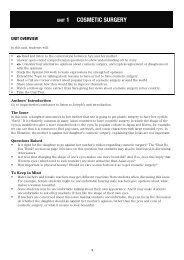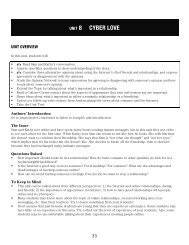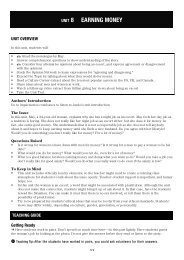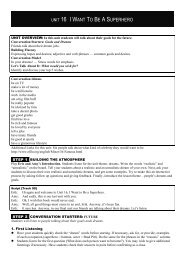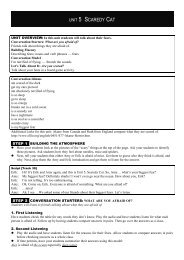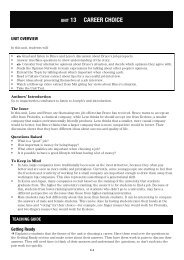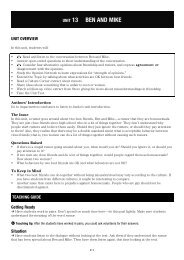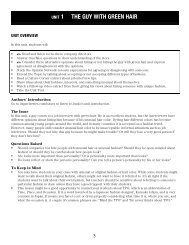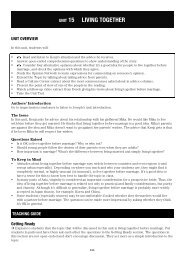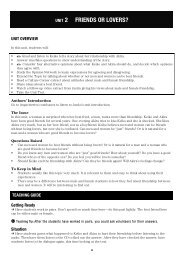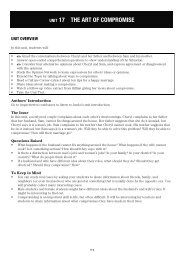UNIT 11 NAOMI'S DILEMMA - Impact Series
UNIT 11 NAOMI'S DILEMMA - Impact Series
UNIT 11 NAOMI'S DILEMMA - Impact Series
Create successful ePaper yourself
Turn your PDF publications into a flip-book with our unique Google optimized e-Paper software.
Sharing My Ideas: Sexual harassment<br />
Choose<br />
Begin by having students read the two situations. Briefly discuss the situations as a class to be sure everyone<br />
understands what each problem is. To help them choose, explain that they are going to give a presentation<br />
about what either Mariko or Shen should do.<br />
Prepare and Rehearse<br />
Have students use the Speaking notes and Language Hints to prepare their presentations. Remind them to<br />
take organized, simple notes.<br />
When they are ready to rehearse, have them work with a partner who chose the same situation. Point out the<br />
Listener task and be sure to allow enough time for students to help each other improve their outlines.<br />
Sample Presentation<br />
I chose Situation B. I think this is sexual harassment. The professor should not ask just one student to go to<br />
coffee. It would be difficult for Shen to say no to her because she is his teacher and a respected professor.<br />
Next time she asks Shen to go to coffee, he should ask if he can invite other students too. He should tell her<br />
that he is sure other students would want to have coffee with her, because they like her and respect her.<br />
They would be thrilled to have time with her. Then it would be difficult for her to say no. To sum up, I think<br />
this is the best way to solve the problem, because no one would get hurt.<br />
Present<br />
Have students find a partner who chose the alternate situation, or put them in small groups. Ask a volunteer<br />
to read the Presentation Tip. You could add that note-taking is another step to becoming a good listener. Be<br />
sure that students have read and understood the Listener task before beginning the presentations.<br />
If you are using the assessment guide below, go over each point with the whole class before students begin<br />
their presentations. (This could also be done during the Rehearse step so that students have time to prepare<br />
for or practice each assessment point.) Be sure to remind your students that communicating their ideas is<br />
more important than trying to use perfect English!<br />
Assessing the Activity<br />
Create a handout with a rating grid such as the one below, or simply write it on the board. (Note: For more<br />
information on student assessment and ways to modify the assessment system, see Assessing the Activity,<br />
Unit 1.)<br />
1 – The presentation was well organized.<br />
2 – The presenter used the Language Hints.<br />
3 – The presenter offered a clear solution to the problem.<br />
4 – The presenter spoke clearly.<br />
5 – The presenter did not read word for word from the page.<br />
When students are working in pairs, have each student evaluate the other. If a student presents in front of a<br />
small group or in front of the class, have each student evaluate him or her. A rater can give up to 5 stars for<br />
each category, so the maximum score for any presentation is 25 stars.<br />
Of course, you can also give your own assessment, along with positive suggestions for how the presenter can<br />
improve next time.<br />
PERSONAL OPINION<br />
If you have downloaded the video clip or have access to the Internet in class, play the video clip. The first<br />
time, have the students watch with books closed. Ask questions to see if the students have understood the<br />
gist of Mei’s opinion. Then have them look at the summary. See if they can fill in the missing words. Play the<br />
extract once or twice more. Then check the answers.<br />
48



